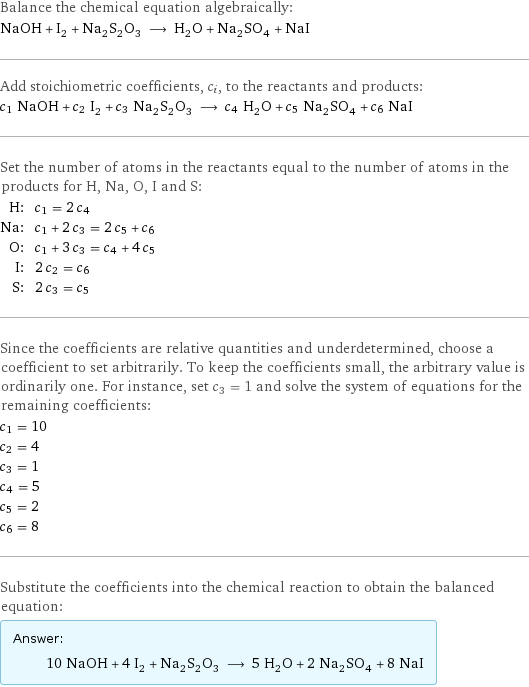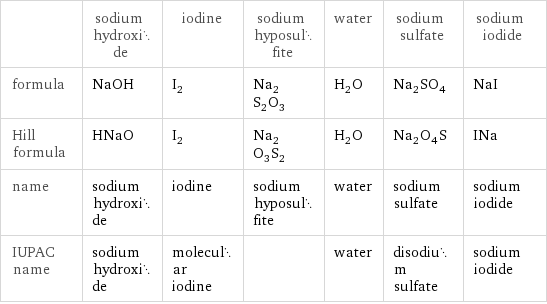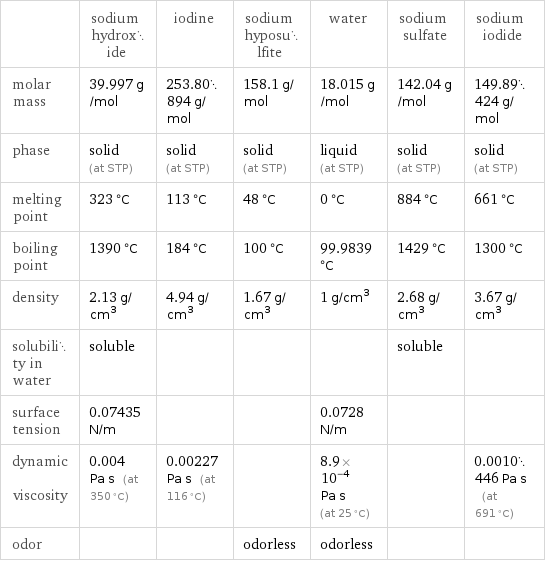Input interpretation

NaOH sodium hydroxide + I_2 iodine + Na_2S_2O_3 sodium hyposulfite ⟶ H_2O water + Na_2SO_4 sodium sulfate + NaI sodium iodide
Balanced equation

Balance the chemical equation algebraically: NaOH + I_2 + Na_2S_2O_3 ⟶ H_2O + Na_2SO_4 + NaI Add stoichiometric coefficients, c_i, to the reactants and products: c_1 NaOH + c_2 I_2 + c_3 Na_2S_2O_3 ⟶ c_4 H_2O + c_5 Na_2SO_4 + c_6 NaI Set the number of atoms in the reactants equal to the number of atoms in the products for H, Na, O, I and S: H: | c_1 = 2 c_4 Na: | c_1 + 2 c_3 = 2 c_5 + c_6 O: | c_1 + 3 c_3 = c_4 + 4 c_5 I: | 2 c_2 = c_6 S: | 2 c_3 = c_5 Since the coefficients are relative quantities and underdetermined, choose a coefficient to set arbitrarily. To keep the coefficients small, the arbitrary value is ordinarily one. For instance, set c_3 = 1 and solve the system of equations for the remaining coefficients: c_1 = 10 c_2 = 4 c_3 = 1 c_4 = 5 c_5 = 2 c_6 = 8 Substitute the coefficients into the chemical reaction to obtain the balanced equation: Answer: | | 10 NaOH + 4 I_2 + Na_2S_2O_3 ⟶ 5 H_2O + 2 Na_2SO_4 + 8 NaI
Structures

+ + ⟶ + +
Names

sodium hydroxide + iodine + sodium hyposulfite ⟶ water + sodium sulfate + sodium iodide
Equilibrium constant
![Construct the equilibrium constant, K, expression for: NaOH + I_2 + Na_2S_2O_3 ⟶ H_2O + Na_2SO_4 + NaI Plan: • Balance the chemical equation. • Determine the stoichiometric numbers. • Assemble the activity expression for each chemical species. • Use the activity expressions to build the equilibrium constant expression. Write the balanced chemical equation: 10 NaOH + 4 I_2 + Na_2S_2O_3 ⟶ 5 H_2O + 2 Na_2SO_4 + 8 NaI Assign stoichiometric numbers, ν_i, using the stoichiometric coefficients, c_i, from the balanced chemical equation in the following manner: ν_i = -c_i for reactants and ν_i = c_i for products: chemical species | c_i | ν_i NaOH | 10 | -10 I_2 | 4 | -4 Na_2S_2O_3 | 1 | -1 H_2O | 5 | 5 Na_2SO_4 | 2 | 2 NaI | 8 | 8 Assemble the activity expressions accounting for the state of matter and ν_i: chemical species | c_i | ν_i | activity expression NaOH | 10 | -10 | ([NaOH])^(-10) I_2 | 4 | -4 | ([I2])^(-4) Na_2S_2O_3 | 1 | -1 | ([Na2S2O3])^(-1) H_2O | 5 | 5 | ([H2O])^5 Na_2SO_4 | 2 | 2 | ([Na2SO4])^2 NaI | 8 | 8 | ([NaI])^8 The equilibrium constant symbol in the concentration basis is: K_c Mulitply the activity expressions to arrive at the K_c expression: Answer: | | K_c = ([NaOH])^(-10) ([I2])^(-4) ([Na2S2O3])^(-1) ([H2O])^5 ([Na2SO4])^2 ([NaI])^8 = (([H2O])^5 ([Na2SO4])^2 ([NaI])^8)/(([NaOH])^10 ([I2])^4 [Na2S2O3])](../image_source/e6724a5f2dd0f9b1152cd42d5784147c.png)
Construct the equilibrium constant, K, expression for: NaOH + I_2 + Na_2S_2O_3 ⟶ H_2O + Na_2SO_4 + NaI Plan: • Balance the chemical equation. • Determine the stoichiometric numbers. • Assemble the activity expression for each chemical species. • Use the activity expressions to build the equilibrium constant expression. Write the balanced chemical equation: 10 NaOH + 4 I_2 + Na_2S_2O_3 ⟶ 5 H_2O + 2 Na_2SO_4 + 8 NaI Assign stoichiometric numbers, ν_i, using the stoichiometric coefficients, c_i, from the balanced chemical equation in the following manner: ν_i = -c_i for reactants and ν_i = c_i for products: chemical species | c_i | ν_i NaOH | 10 | -10 I_2 | 4 | -4 Na_2S_2O_3 | 1 | -1 H_2O | 5 | 5 Na_2SO_4 | 2 | 2 NaI | 8 | 8 Assemble the activity expressions accounting for the state of matter and ν_i: chemical species | c_i | ν_i | activity expression NaOH | 10 | -10 | ([NaOH])^(-10) I_2 | 4 | -4 | ([I2])^(-4) Na_2S_2O_3 | 1 | -1 | ([Na2S2O3])^(-1) H_2O | 5 | 5 | ([H2O])^5 Na_2SO_4 | 2 | 2 | ([Na2SO4])^2 NaI | 8 | 8 | ([NaI])^8 The equilibrium constant symbol in the concentration basis is: K_c Mulitply the activity expressions to arrive at the K_c expression: Answer: | | K_c = ([NaOH])^(-10) ([I2])^(-4) ([Na2S2O3])^(-1) ([H2O])^5 ([Na2SO4])^2 ([NaI])^8 = (([H2O])^5 ([Na2SO4])^2 ([NaI])^8)/(([NaOH])^10 ([I2])^4 [Na2S2O3])
Rate of reaction
![Construct the rate of reaction expression for: NaOH + I_2 + Na_2S_2O_3 ⟶ H_2O + Na_2SO_4 + NaI Plan: • Balance the chemical equation. • Determine the stoichiometric numbers. • Assemble the rate term for each chemical species. • Write the rate of reaction expression. Write the balanced chemical equation: 10 NaOH + 4 I_2 + Na_2S_2O_3 ⟶ 5 H_2O + 2 Na_2SO_4 + 8 NaI Assign stoichiometric numbers, ν_i, using the stoichiometric coefficients, c_i, from the balanced chemical equation in the following manner: ν_i = -c_i for reactants and ν_i = c_i for products: chemical species | c_i | ν_i NaOH | 10 | -10 I_2 | 4 | -4 Na_2S_2O_3 | 1 | -1 H_2O | 5 | 5 Na_2SO_4 | 2 | 2 NaI | 8 | 8 The rate term for each chemical species, B_i, is 1/ν_i(Δ[B_i])/(Δt) where [B_i] is the amount concentration and t is time: chemical species | c_i | ν_i | rate term NaOH | 10 | -10 | -1/10 (Δ[NaOH])/(Δt) I_2 | 4 | -4 | -1/4 (Δ[I2])/(Δt) Na_2S_2O_3 | 1 | -1 | -(Δ[Na2S2O3])/(Δt) H_2O | 5 | 5 | 1/5 (Δ[H2O])/(Δt) Na_2SO_4 | 2 | 2 | 1/2 (Δ[Na2SO4])/(Δt) NaI | 8 | 8 | 1/8 (Δ[NaI])/(Δt) (for infinitesimal rate of change, replace Δ with d) Set the rate terms equal to each other to arrive at the rate expression: Answer: | | rate = -1/10 (Δ[NaOH])/(Δt) = -1/4 (Δ[I2])/(Δt) = -(Δ[Na2S2O3])/(Δt) = 1/5 (Δ[H2O])/(Δt) = 1/2 (Δ[Na2SO4])/(Δt) = 1/8 (Δ[NaI])/(Δt) (assuming constant volume and no accumulation of intermediates or side products)](../image_source/439ab3ab0583367396dc983c271cef58.png)
Construct the rate of reaction expression for: NaOH + I_2 + Na_2S_2O_3 ⟶ H_2O + Na_2SO_4 + NaI Plan: • Balance the chemical equation. • Determine the stoichiometric numbers. • Assemble the rate term for each chemical species. • Write the rate of reaction expression. Write the balanced chemical equation: 10 NaOH + 4 I_2 + Na_2S_2O_3 ⟶ 5 H_2O + 2 Na_2SO_4 + 8 NaI Assign stoichiometric numbers, ν_i, using the stoichiometric coefficients, c_i, from the balanced chemical equation in the following manner: ν_i = -c_i for reactants and ν_i = c_i for products: chemical species | c_i | ν_i NaOH | 10 | -10 I_2 | 4 | -4 Na_2S_2O_3 | 1 | -1 H_2O | 5 | 5 Na_2SO_4 | 2 | 2 NaI | 8 | 8 The rate term for each chemical species, B_i, is 1/ν_i(Δ[B_i])/(Δt) where [B_i] is the amount concentration and t is time: chemical species | c_i | ν_i | rate term NaOH | 10 | -10 | -1/10 (Δ[NaOH])/(Δt) I_2 | 4 | -4 | -1/4 (Δ[I2])/(Δt) Na_2S_2O_3 | 1 | -1 | -(Δ[Na2S2O3])/(Δt) H_2O | 5 | 5 | 1/5 (Δ[H2O])/(Δt) Na_2SO_4 | 2 | 2 | 1/2 (Δ[Na2SO4])/(Δt) NaI | 8 | 8 | 1/8 (Δ[NaI])/(Δt) (for infinitesimal rate of change, replace Δ with d) Set the rate terms equal to each other to arrive at the rate expression: Answer: | | rate = -1/10 (Δ[NaOH])/(Δt) = -1/4 (Δ[I2])/(Δt) = -(Δ[Na2S2O3])/(Δt) = 1/5 (Δ[H2O])/(Δt) = 1/2 (Δ[Na2SO4])/(Δt) = 1/8 (Δ[NaI])/(Δt) (assuming constant volume and no accumulation of intermediates or side products)
Chemical names and formulas

| sodium hydroxide | iodine | sodium hyposulfite | water | sodium sulfate | sodium iodide formula | NaOH | I_2 | Na_2S_2O_3 | H_2O | Na_2SO_4 | NaI Hill formula | HNaO | I_2 | Na_2O_3S_2 | H_2O | Na_2O_4S | INa name | sodium hydroxide | iodine | sodium hyposulfite | water | sodium sulfate | sodium iodide IUPAC name | sodium hydroxide | molecular iodine | | water | disodium sulfate | sodium iodide
Substance properties

| sodium hydroxide | iodine | sodium hyposulfite | water | sodium sulfate | sodium iodide molar mass | 39.997 g/mol | 253.80894 g/mol | 158.1 g/mol | 18.015 g/mol | 142.04 g/mol | 149.89424 g/mol phase | solid (at STP) | solid (at STP) | solid (at STP) | liquid (at STP) | solid (at STP) | solid (at STP) melting point | 323 °C | 113 °C | 48 °C | 0 °C | 884 °C | 661 °C boiling point | 1390 °C | 184 °C | 100 °C | 99.9839 °C | 1429 °C | 1300 °C density | 2.13 g/cm^3 | 4.94 g/cm^3 | 1.67 g/cm^3 | 1 g/cm^3 | 2.68 g/cm^3 | 3.67 g/cm^3 solubility in water | soluble | | | | soluble | surface tension | 0.07435 N/m | | | 0.0728 N/m | | dynamic viscosity | 0.004 Pa s (at 350 °C) | 0.00227 Pa s (at 116 °C) | | 8.9×10^-4 Pa s (at 25 °C) | | 0.0010446 Pa s (at 691 °C) odor | | | odorless | odorless | |
Units
